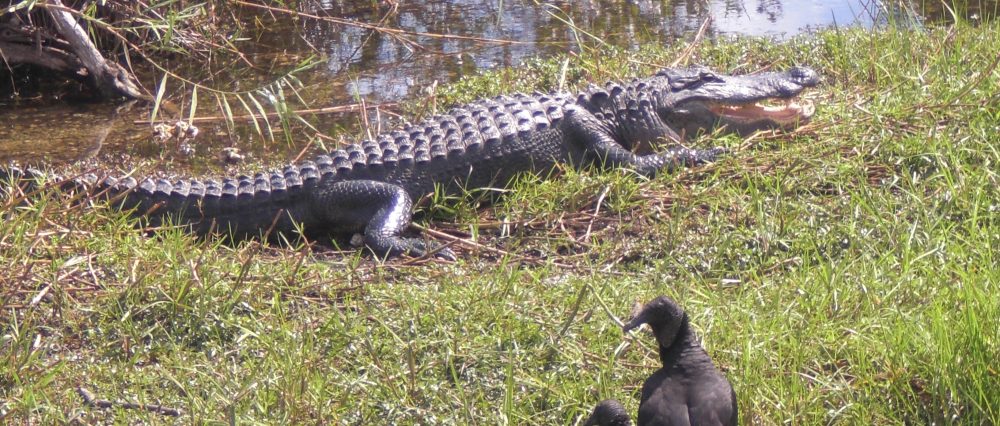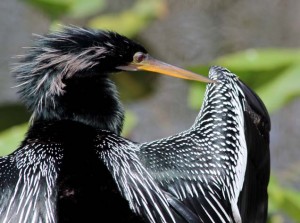Tramping the Everglades without leaving footprints is a challenge
By Carmine Colangelo
On a typical sunny day in March hundreds of visitors from around the world have come to the Anhinga Trail in Everglades National Park. They see alligators and the exotic wildlife of South Florida, sometimes only inches from the trail. But patrons need to cover their parked cars with tarps that are provided because the vultures like to peck at the rubber on windshields.
People and nature are mixing.
Every year nearly one million people visit Everglades National Park in south Florida to marvel at the natural wonders of the preserve. But with that much traffic going through the park, visitors can’t help but made a big footprint on the environment.
In comparison to other parks like Grand Smoky Mountains, which sees about 10 million visitors annually, Everglades National Park’s annual visitation rate is much smaller for its size. There are reasons for that. “For nine months out of the year it’s pretty brutal out here,” said Larry Perez a science communications interpreter at Everglades National Park, hinting at harsh temperatures and the high level of bugs. Plus the park’s 1.5 million acres make it the third largest national park in the lower 48 states.
“It’s always a challenge,” said Jenny Guerra, a ranger at Everglades “Especially with the littering… We want people to visit and we want people to appreciate it and have some sort of ownership of the parks, but of course you have to balance that out with the impacts of having so many visitors.”
While Everglades National Park is surrounded by a metropolitan area with over six million people, few of those people visit the park.
According to an Everglades National Park visitors study, roughly 40 percent of visitors are from foreign countries, primarily Europe and Canada.
Lyle Kenyon, an older man from Gulliver, Mich. has visited Everglades National Park several times and comes down to Florida to enjoy the scenery. As much as he enjoys his time in the Everglades he is concerned about the future of the park. “I don’t think they can replace it once they get rid of it,” said Kenyon. “They better keep it because there are not a lot of people that have seen it yet.”
No matter where they come from, most of these nearly million park visitors get around by car. Vehicles entering a national park have proved an issue in such parks as Grand Canyon, which has banned cars during busy seasons and insisted that visitors ride buses.
So far that has not happened at Everglades.
“In our efforts to try and mitigate the effects of climate change within our park, our number one contributor to carbon emissions in the park is visitor vehicles,” said Perez. “We’ve talked for many years about curtailing that by using a mass transportation system in the park. We may see that in future years.”
But most visitors are on their best behavior.
“Fortunately, a lot of people that visit national parks know how to behave in national parks,” said Guerra.
Signs help, such as those posted in popular areas like the Anhinga Trail, which reads “do not feed the alligator, $500 fine”.
Wildlife officials said that if alligators are caught being fed by people the large reptiles have to be killed. Alligators never act the same and become a danger to everyone, including park visitors.
Some wildlife has difficulty with human visitors. For example the Roseate Spoonbill, which is a wading bird known for its distinctive pink plumage, will nest in the Florida Bay area. When the bird does begin to nest measurable closures will be enacted within the rookeries in order to keep appropriate distance from disturbing the wildlife.
Yet other wildlife has learned to live with human visitors. Birds like the Anhinga and the Cormorant can be found perched along the Anhinga Trail and act like there are not any visitors at all . The birds can be found on the railings, sitting only feet away from visitors.
One popular activity is slough slogging, where visitors get to hike through the river of grass and explore cypress domes and alligator holes. But even here problems can develop. “One of the slough slogs that we do, was used so often and so many people trekked through it, we could actually see the path to the dome from Google Earth,” said Guerra. “In that case we stopped doing slogs in that area. We gave it a couple years to restore itself and then go to other domes.”
One day in March Kirk Singer, another park ranger, took a group of 13 people out on a slog walk. Using walking sticks furnished by Singer, the group started on a road that was built over a hundred years ago and then veered into a large opening of saw grass. The group pushed their way through the brush seeing evidence of alligators and snakes as well as several birds from the area. They hiked for several miles before returning to a trail. After all that walking in a heavily vegetated area that looked like wilderness, the group realizes that they were actually much closer to the highly-populated Anhinga Trail than they thought.
The challenge at Everglades National Park is to now keep the proper balance between the tourism and nature.
“It depends on what you call natural,” said Perez. “The park will always be a wilderness area. It will be a place that will preserve that characteristic wildness. Whether the park will retain the same character, the same natural abundance and diversity of life that we’ve come to enjoy is seriously in question.”


